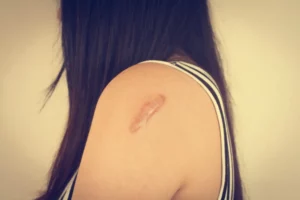 Understanding keloid scars and their causes is the first step toward effective management.
Understanding keloid scars and their causes is the first step toward effective management.
While complete removal might be challenging, various treatment options, including corticosteroid injections, surgical excision, laser therapy, and radiation, offer promising results.
Consulting with a dermatologist or plastic surgeon can help determine the most suitable approach based on the individual’s specific case and preferences.
Decoding Keloid Scars
Keloid scars are a type of raised scar that extends beyond the boundaries of the original wound. Unlike typical scars that gradually fade, keloids can grow over time, becoming larger and more prominent. These scars are a result of an overproduction of collagen during the healing process.
Causes of Keloid Formation
Various factors contribute to the formation of keloid scars. Genetic predisposition plays a role, as individuals with a family history of keloids are more susceptible.
Additionally, certain skin types, particularly those with higher levels of melanin, are more prone to keloid development. Trauma, such as surgical incisions, acne scars, or even minor cuts, can trigger excessive collagen production leading to keloid formation.
Prevention Strategies
While complete prevention is challenging, there are strategies to minimize the risk of keloid formation. Gentle wound care, avoiding unnecessary skin trauma, and using silicone sheets or gels during the healing process can help reduce the likelihood of keloid development. Early intervention and proper wound management are crucial in preventing excessive scar tissue formation.
Corticosteroid Injections
One common method for reducing the size and appearance of keloids is corticosteroid injections. These injections work by reducing inflammation and inhibiting collagen production. While effective for many individuals, multiple sessions may be required, and results can vary.
Surgical Excision
Surgical excision involves removing the entire keloid. However, this method comes with a caveat, as surgery alone may trigger further keloid formation. To mitigate this risk, surgeons often combine excision with other treatments, such as corticosteroid injections or radiation therapy.
Laser Therapy
Laser therapy is another option for treating keloid scars. The laser targets the excessive collagen in the scar tissue, breaking it down and promoting a smoother skin appearance. Laser treatments are generally well-tolerated and can be effective, particularly when combined with other approaches.
Radiation Therapy
Radiation therapy is employed to reduce the likelihood of keloid recurrence after surgical excision. It works by inhibiting collagen production, and preventing the formation of new keloids. While effective, radiation therapy is typically reserved for cases where other treatments may not be suitable.
Picture Credit: Freepik
